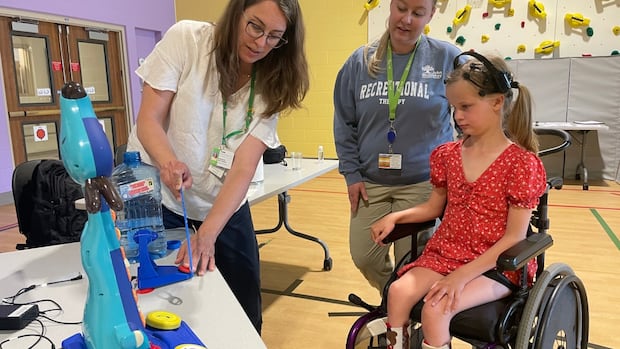[
It sounds like something from a futuristic film: Technology that allows users to control their environment with mere thoughts.
But for kids with disabilities in Ontario, it’s an emerging reality that’s helping them connect with the world around them in unprecedented ways.
For 10-year-old Irelynn, who’s non-verbal and has limited mobility, it means she can make a toy play music just by thinking about clapping.
“Probably the best thing I’ve ever seen,” says her dad, Jeff.

CBC News has agreed not to use Irelynn or her dad’s last name due to privacy and safety concerns.
The technology, known as brain computer interface (BCI), relies on a black headset equipped with several circular sensors that listen to electrical signals inside Irelynn’s head.
“She has taught software to recognize a particular command thought,” says Susannah Van Damme, an occupational therapist and the team lead of the clinical BCI program at Holland Bloorview Kids Rehabilitation Hospital in Toronto.
“So for Irelynn, she loves applause, she loves clapping, so that was the first command thought that we worked with.”
Van Damme led the recent session with Irelynn at the John McGivney Children’s Centre in Windsor, Ont. The centre, which provides services and care to local kids with disabilities, is among the first in the province to train with the tool.
A $30 million donation from the Slaight Family Foundation late last year is helping spread the technology beyond Holland Bloorview, which pioneered it.

Jodi Fischer, manager for occupational therapy and physiotherapy at McGivney, says the training is in the early stages, but that it’s been “very exciting” so far.
“They see a way that they get to control their environment […] in a way that they’ve never been able to do in lots of instances,” she says.
“It’s giving them a tool that they didn’t know was possible.”
She said one boy she’s worked with for years used the technology to make a machine throw a ball — something that could be integrated into a group program, or even allow him to play with his family in the future.
“It is very emotional, and we’ve seen that time and time again in different demos,” she said.
The technology, built on decades of research at Holland Bloorview, is far from perfect. It takes a while for staff in the McGivney gymnasium to secure the headset and its multiple sensors in just the right spots on Irelynn.
But Irelynn, wearing pigtails and a red summer dress, sits calmly in her wheelchair. She’s done this before.

“In order for us to get those signals, we need to make sure every electrode is making good contact with her skull,” Van Damme said.
“So we have to move hair around. We have little felts that are soaked in saline solution so that salt helps with conductivity,” she said. “And once we know that the headset is well connected, then we’re able to move forward and train the system to recognize when she wants to activate a toy.”
The current headsets were designed for adults, Van Damme says, so she hopes they can keep improving the technology.

But for Jeff, Irelynn’s father, the device has already opened up their worlds. She was diagnosed with STXBP1 disorder, a rare genetic condition, when she was a toddler, he says.
“It just shows that children are capable of so much more than what we really know,” he said.
Both Jeff and Fischer, the therapy manager at McGivney, said the tool gives them hope for what technology could do for people with disabilities in the future.
“Who knows where it will go?” she said.
